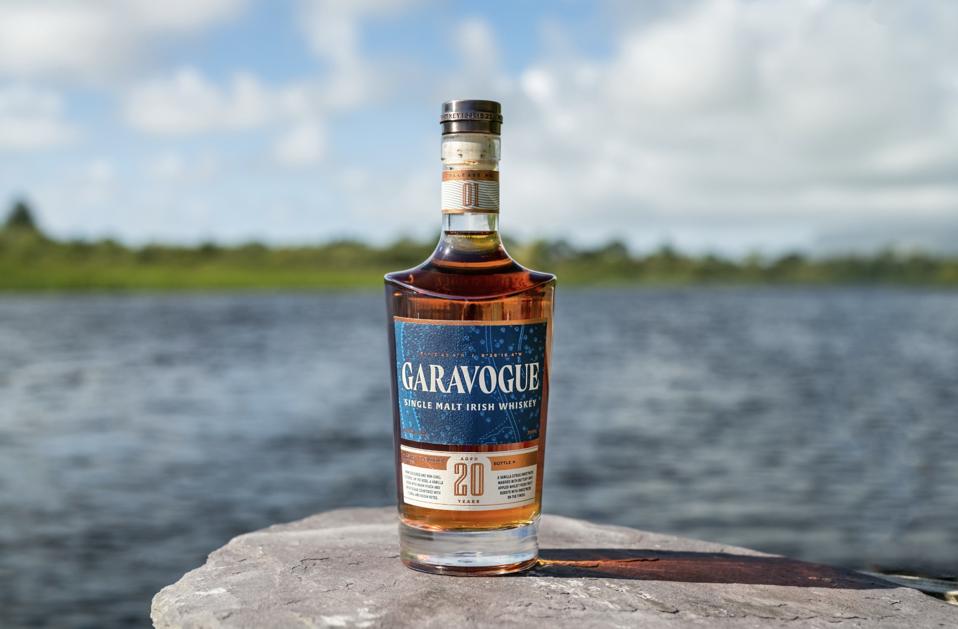In Sligo, Ireland, a short stretch of river called the Garavogue flows from Lough Gill to the sea. It’s not long or dramatic, but it’s central—threading past the town’s stone bridges and through its history. The river gave the town its rhythm. Now it gives its name to something new: a whiskey that feels both rooted and restless.
Garavogue 20-Year-Old Single Malt Irish Whiskey is the first release from Hawk’s Rock Distillery, the newly renamed site formerly known as Lough Gill. It’s also the first Irish whiskey launched under the ownership of the Sazerac Company, which acquired the distillery in 2021 and quietly let time, wood, and weather do their work.
And while there’s plenty of buzz around the rebrand and rollout, the most interesting thing about this whiskey isn’t what’s on the label. It’s what’s in the glass—and how it came to be there.
Helen Mulholland Had Time—and Freedom
When Helen Mulholland joined the Hawk’s Rock team, she was already a legend in the world of Irish whiskey. The first woman to ever hold the title of Master Blender in the industry, she’s spent over three decades defining what Irish single malt can be. But Garavogue? This was something else entirely.
“Never in my lifetime have I created a whiskey like this,” she said during a recent media tasting. “As a blender, you’re taught to be restrained, to find balance. This—this was about letting go a little.”
She began with what she calls the “canvas”—a whiskey that had spent 14 years aging in ex-bourbon barrels. “That bourbon gives it honey, vanilla, a beautiful face to start playing with,” she said.
From there, she started layering. Not just one or two finishing casks, as is common in high-end Irish whiskey, but five—each one pulling the liquid in a different direction, without letting it fall apart.
And somehow, it didn’t.
A Risky Number of Casks
The final whiskey is built from an ensemble of barrels that don’t usually share the same stage. After its time in bourbon casks, the whiskey was portioned into:
- French Muscat casks, which added floral and earthy notes—lavender, honey, even something savory. “Muscat helps take the sweetness down a bit,” Mulholland explained. “I didn’t want it to be sugary.”
- French Sauternes casks, layered in next, brought back fruit and brightness: apricot, ripe peach, spun sugar. “It gives lift,” she said. “It brings in this fresh, juicy character.”
- Barbadian rum casks, her maybe-favorite (she wouldn’t say), gave the whiskey a warm sweetness—burnt sugar, toffee, creamy richness. “It anchors the blend. That’s what rum does. It gives weight.”
- Pedro Ximénez (PX) sherry casks, including some as old as 40 years, were used for about 18 months at the end of the process to deepen the profile without burying it. “PX can dominate if you’re not careful,” she said. “Here, it just brings a little dried fruit, a little warmth.”
These casks weren’t used sequentially—they were finished separately, then blended. Each component remained visible in the final pour, like instruments in a well-mixed track. “We don’t want to mask anything,” Mulholland said. “You should be able to pick them out. And when you come back to the glass, it should give you something new.”
No Finish Line, Just Balance
By the time Mulholland stopped tinkering, Garavogue had passed through more cask types than most brands would touch in a decade.
“It wasn’t the plan,” she admitted. “We kept adding. We kept layering. And the more we did, the more it worked.”
It wasn’t about flash or novelty. It was about balance—a word she used repeatedly during the tasting, but not as a euphemism for safe or predictable. In this context, it meant building a whiskey that could hold tension. Something sweet but not cloying. Complex but not chaotic. A whiskey that could evolve in the glass, or even just in the mood of the person drinking it.
“It’s balanced,” she said. “But it’s layered. It changes. It’s emotional.”
Bottled with Intention
The final product is bottled at 47% ABV, unfiltered and without artificial coloring. It’s strong enough to stand up to a splash of water—“which I encourage, if you like,” said Mulholland—but soft enough to sip neat.
“If someone poured Coke in it, they might get a look of concern,” she joked. “But ultimately, it’s your bottle.”
The design of that bottle nods back to the river that inspired it. Its reversed crescent shape and wave-textured glass recall flowing water, while the label includes the coordinates for Hazelwood House Windmill, a local landmark visible from the distillery grounds. It’s a small touch, but one that ties the liquid inside to the place it came from.
A First Step, Not a Final Word
Garavogue is being billed as Batch No. 1, which, according to Sazerac VP Jess Scheerhorn, is more than marketing language. It’s a signal.
“This isn’t a one-off,” he said. “We’re making a statement not just about what we can do, but where we’re going.”
Future Garavogue releases might not be 20 years old. They might not even be single malts. What they will be, according to Mulholland, is “curious.” That seems to be the thread running through this entire project: a willingness to follow the whiskey wherever it wants to go.
“It’s balanced. But it’s layered. It changes in the glass. It’s playful, it’s serious, it’s emotional,” said Mulholland. “I just wanted to create something that would make people come back to the glass again and again.”
For now, Garavogue 20-Year-Old will roll out in limited quantities starting in June 2025, priced at $199 (700ml). It will be available through select retailers in the U.S., Ireland, the U.K., and Duty-Free, as well as on Legacy de Forge, Sazerac’s new digital platform for rare and collectible spirits.
And once it’s gone, it’s gone.

